
Nostalgia......yesteryear Actresses
  |
| maheshks |
 Jun 18 2007, 01:41 AM Jun 18 2007, 01:41 AM
Post
#256
|
 Dedicated Member  Group: Members Posts: 2700 Joined: 6-March 05 From: In front of my P.C. Member No.: 1790 |
NO.. not about her illness but about the kazi thing and the statement that
she got married to kishore kumar only after dilip and saira got married. They got married in 1966 while madhubala and kishore in 1961. Accounts of events given are misleading and lop sided. I personally know many old timers here in Mumbai who were witnesses to all those events. It pains me when I read such fanciful thoughts errupted out of flight of imagination. Which biography are you mentioning about? Let me see. When you find peace within yourself, you become the kind of person who can live at peace with others
|
| Reeth |
 Jun 18 2007, 02:54 PM Jun 18 2007, 02:54 PM
Post
#257
|
 Dedicated Member  Group: Members Posts: 2154 Joined: 22-May 06 Member No.: 6151 |
NO.. not about her illness but about the kazi thing and the statement that she got married to kishore kumar only after dilip and saira got married. They got married in 1966 while madhubala and kishore in 1961. Accounts of events given are misleading and lop sided. I personally know many old timers here in Mumbai who were witnesses to all those events. It pains me when I read such fanciful thoughts errupted out of flight of imagination. Which biography are you mentioning about? Let me see. I am sorry about that....i am trying to locate the article where i got that from, which as you say is not correct....infact kishore kumar and Madhubala had a civil marriage in 1960 and later he is supposed to have converted to islam and got married according to muslim rites which angered his family.....i should have rechecked before writing that... however the qazi incident has been quoted in a couple of other articles as well other than the one i mentioned earlier... The greatest discovery of my generation is that human beings can alter their lives by altering their attitudes of mind -William James |
| nasir |
 Jun 18 2007, 08:59 PM Jun 18 2007, 08:59 PM
Post
#258
|
|
Dedicated Member  Group: Members Posts: 3170 Joined: 22-April 06 From: Mumbai, India. Member No.: 5763 |
NO.. not about her illness but about the kazi thing and the statement that she got married to kishore kumar only after dilip and saira got married. They got married in 1966 while madhubala and kishore in 1961. Accounts of events given are misleading and lop sided. I personally know many old timers here in Mumbai who were witnesses to all those events. It pains me when I read such fanciful thoughts errupted out of flight of imagination. Which biography are you mentioning about? Let me see. I am sorry about that....i am trying to locate the article where i got that from, which as you say is not correct....infact kishore kumar and Madhubala had a civil marriage in 1960 and later he is supposed to have converted to islam and got married according to muslim rites which angered his family.....i should have rechecked before writing that... however the qazi incident has been quoted in a couple of other articles as well other than the one i mentioned earlier... Reeth, on conversion, did KK change his name to ABDUL REHMAN? Is that mentioned somewhere? Nasir. NASIR
Teri Khushi me.n Khush Tera banda khidmatgaar hai, Banda hoo.n mai.n Tera Tuu mera Parwardigaar hai. |
| Reeth |
 Jun 19 2007, 02:57 PM Jun 19 2007, 02:57 PM
Post
#259
|
 Dedicated Member  Group: Members Posts: 2154 Joined: 22-May 06 Member No.: 6151 |
NO.. not about her illness but about the kazi thing and the statement that she got married to kishore kumar only after dilip and saira got married. They got married in 1966 while madhubala and kishore in 1961. Accounts of events given are misleading and lop sided. I personally know many old timers here in Mumbai who were witnesses to all those events. It pains me when I read such fanciful thoughts errupted out of flight of imagination. Which biography are you mentioning about? Let me see. I am sorry about that....i am trying to locate the article where i got that from, which as you say is not correct....infact kishore kumar and Madhubala had a civil marriage in 1960 and later he is supposed to have converted to islam and got married according to muslim rites which angered his family.....i should have rechecked before writing that... however the qazi incident has been quoted in a couple of other articles as well other than the one i mentioned earlier... Reeth, on conversion, did KK change his name to ABDUL REHMAN? Is that mentioned somewhere? Nasir. Not sure abt that nasir, i can look it up.... The greatest discovery of my generation is that human beings can alter their lives by altering their attitudes of mind -William James |
| jassi |
 Jun 19 2007, 03:19 PM Jun 19 2007, 03:19 PM
Post
#260
|
|
Regular Member  Group: Members Posts: 650 Joined: 27-November 06 Member No.: 7657 |
it may upset kishore fans but i wonder as he married abt four times..
what he was looking for |
| jassi |
 Jun 19 2007, 03:19 PM Jun 19 2007, 03:19 PM
Post
#261
|
|
Regular Member  Group: Members Posts: 650 Joined: 27-November 06 Member No.: 7657 |
let me know if kishore ever sing for dilip kumar or not
|
| jassi |
 Jun 19 2007, 03:33 PM Jun 19 2007, 03:33 PM
Post
#262
|
|
Regular Member  Group: Members Posts: 650 Joined: 27-November 06 Member No.: 7657 |
Suchitra Sen(Bengali),Padmini(South) & Sandhya(Marathi) they all were not regular Bollywood Actresses,but they did some fine work in Bollywood too.Sandhya later became part of Hindi films,but there was always gap in her film.Suchitra and Padmini did Hindi Films,when they got something nice to do.Here are biographies of these three Regional Actresses.....
Suchitra Sen  Born in 1931 in Patna,Suchitra Sen was the most popular actress that Bengali Cinema has ever seen. Her beauty and acting talent was just superb.All this gave her a legendary cult status in Bengal.Her debut was in the unreleased Shesh Kothai made in 1952 oppocite Uttam Kumar.They went on to become icons of Bengali romantic melodramas for more than twenty years .She was already a superstar of Bengal,but did good work in Bollywood too.She did not get much success in Bollywood may be because of language problems. Her first Hindi film was Bimal roy s Devdas (1955),she played role of Paro and got critical acclaim for her. Later she did few hindi films Bambai Ka Babu & Musafir but these films could not do well at the box office.Mamta and Aandhi were her two best performances of hindi films.Mamta and Aandhi were her two best performances of hindi films.She retired from the screen in 1978.A devotee of Ramakrishna Mission, Suchitra now immerses herself in meditation and prayer.Her daughter Moon Moon Sen(who is just remembered for exposing) and grand daughters Riya and Raima(both are doing well as comparison to their mother) are all actresses as well.  She got filmfare nomination of best actress award for Mamta and Aandhi. Suchitra Sen is the first Indian actress awarded in an international film festival. She received the Best Actress award for the movie saat paake bandha in 1963 Moscow film festival.Some of her Bengali films also remaked in Hindi for eg. Khamoshi(Wahida Rehmaan,Dharemndra & Rajesh Khanna) and Kora Kagaj(Vijay Anand,Jaya Bachan). Her Performances(In Hindi)-Devdas(Dalip K,Vyajantimala),Champakali(with Bharat Bhushan),Musafir(with Dalip K,Kishore K),Mamta(with Ashok K,Dharamendra),Bambai Ka Babu(with Dev Anand),Aandhi(with Sanjeev Kumar) and couple of Bengali films. |
| jassi |
 Jun 19 2007, 03:37 PM Jun 19 2007, 03:37 PM
Post
#263
|
|
Regular Member  Group: Members Posts: 650 Joined: 27-November 06 Member No.: 7657 |
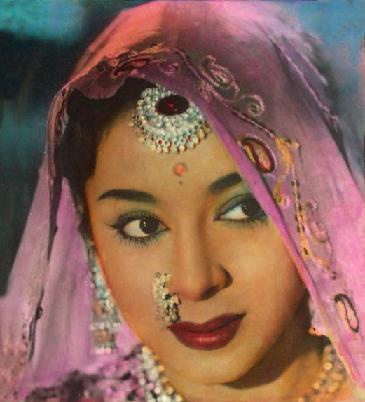 Padmini Born in 1932,Padmini was small time bollywood actress,but she was super star in south and did good work in hindi films too.Her elder sister Lalitha and younger sister Ragini were also renowned film actresses.Padmini had her early education at Mahila Mandiram School and at Sea Shell convent in Thiruvananthapuram. Later she devoted her entire time and energy in pursuing classical dance and has been religiously doing it for the past 64 years.At 14, she became a member of a dance troupe that toured various parts of India. At the age of 17, Padmini became the heroine of the Hindi film "Kalpana," .Later she did films like Jis desh mein ganga behti hai. She then went on to act in Hindi, Tamil, Telugu, Kannada, and Malayalam films.But she nevar did so many films in Hindi.Padmini has acted with all the leading heroes during that age, which include legendary stars like Raj Kapoor, Dev Anand,Rajinder Kumar,Dharamendra,Sivaji Ganesan, MGR, Prem Nazir, and Raj Kumar.She got married to Dr. KT Ramachandran in 1961.Her Mera Naam Joker s one scene create lot of hoo haa. She left the soaring acting career and settled for family life. 1977, she started her own school 'Padmini School of Fine Arts' at the basement of her house in New Jersey with four students.Late film actress Richa Sharma, Sanjay Dutt's wife was one of her students. She is a founder-member of the Hindu Temple Society of North American. She is also associated with many charities.In 1981 her husband died at the age of 48. Their only son Premanand is an official with the Warner Brothers. He acted in one Malayalam movie and produced three documentaries. 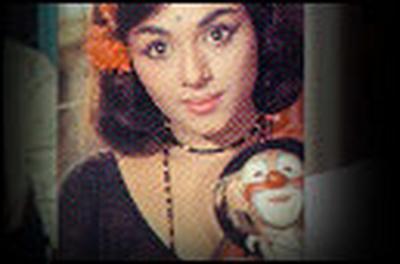 She got Filmfare Best Actress Nomination for Jis Desh Mein Ganga Behti Hai and Filmfare Best Supportiung Actress Nomintation for Kaajal and she won the award Kaajal and also won Best actress awards(South) of the Film Fans Association in 1954,'59,'61 and '66. Her Performances-Kalpana(with Ashok K),Kaajal(with Meena K,Rajkumar,Dharamendra),Jis Desh Mein Ganga Behti Hai(with Raj K),Bhai Behan(with Ashok K,Sunil D,Nutan),Mahabharat(with Pradeep K,Dara Singh),Vaasna(with Rajkumar,Biswajeet),Chanda aur Bijli(with Sanjeev Kumar,Sachin) and Mera Naam Joker(with Raj K,Rajendra K,Dharamendra,Manoj K,Simi,Rishi Kapoor)etc. |
| jassi |
 Jun 19 2007, 03:40 PM Jun 19 2007, 03:40 PM
Post
#264
|
|
Regular Member  Group: Members Posts: 650 Joined: 27-November 06 Member No.: 7657 |
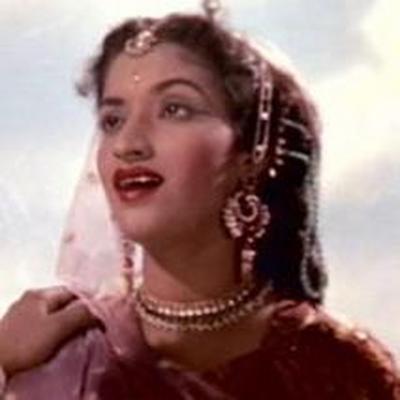 Sandhya Sandhya was Marathi Actress,who later joined Hindi Films in 50s,She is known for her dances in hindi films and song E Malik Tere Bande Hum.She did very few films,but we can consider her most of films as classic.She mostly worked with V.Shantaram,whom she got married later.She was second wife of V.Shantaram.She was different from other actresses from her era,may be that’s coz she was not part of Raj Kapoor kind romance or Bimal roy kinda social films.She got good reviews for Navrang,she was acclaimed for her crossdressing holi song 'are ja re natkhat',where she appeared in both man & woman s role.Her Films were also based on Dance,Romance and Social Issues but they were not typical bollywood flicks.The other reason can be that she was not paired oppocite stars like Raj Kapoor,Daleep Kumar,Dev Anand etc.So she was not in the stage like other actresses.She was even not continuely doing films,most of her films came after litlle gap.In the beginning of 70s she alsmost stopped doing films and started looking after her family. 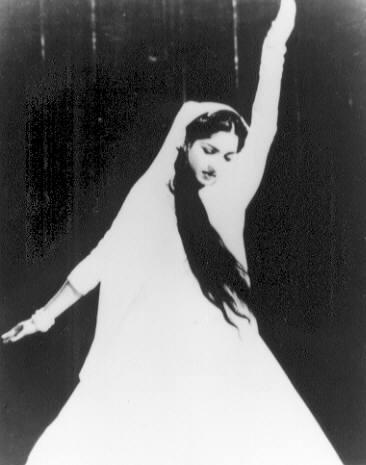 She got Lifetime Achievment Award for her contribution to cinema by Marathi Film Accosiation in 2000. Her Performances-Teen Batti Chaar Raaste(with Karan Diwan),Jhanak Jhanak Payal Baaje(with Mehipal & Madan Puri),Navrang(with Mehipal),Do Aankhen Barah Haath(with V.Shantaram),Jal Bin Machali Nritiya Bin Bijli(with Abhijeet),Sehra(with Prashant) and Pinjra(with Dr.Shri Ram Lagoo) |
| Reeth |
 Jun 19 2007, 08:27 PM Jun 19 2007, 08:27 PM
Post
#265
|
 Dedicated Member  Group: Members Posts: 2154 Joined: 22-May 06 Member No.: 6151 |
it may upset kishore fans but i wonder as he married abt four times.. what he was looking for I guess he did marry four times, but that is his personal choice ....... The greatest discovery of my generation is that human beings can alter their lives by altering their attitudes of mind -William James |
| Reeth |
 Jun 19 2007, 08:29 PM Jun 19 2007, 08:29 PM
Post
#266
|
 Dedicated Member  Group: Members Posts: 2154 Joined: 22-May 06 Member No.: 6151 |
Suchitra Sen(Bengali),Padmini(South) & Sandhya(Marathi) they all were not regular Bollywood Actresses,but they did some fine work in Bollywood too.Sandhya later became part of Hindi films,but there was always gap in her film.Suchitra and Padmini did Hindi Films,when they got something nice to do.Here are biographies of these three Regional Actresses..... Suchitra Sen  Born in 1931 in Patna,Suchitra Sen was the most popular actress that Bengali Cinema has ever seen. Her beauty and acting talent was just superb.All this gave her a legendary cult status in Bengal.Her debut was in the unreleased Shesh Kothai made in 1952 oppocite Uttam Kumar.They went on to become icons of Bengali romantic melodramas for more than twenty years .She was already a superstar of Bengal,but did good work in Bollywood too.She did not get much success in Bollywood may be because of language problems. Her first Hindi film was Bimal roy s Devdas (1955),she played role of Paro and got critical acclaim for her. Later she did few hindi films Bambai Ka Babu & Musafir but these films could not do well at the box office.Mamta and Aandhi were her two best performances of hindi films.Mamta and Aandhi were her two best performances of hindi films.She retired from the screen in 1978.A devotee of Ramakrishna Mission, Suchitra now immerses herself in meditation and prayer.Her daughter Moon Moon Sen(who is just remembered for exposing) and grand daughters Riya and Raima(both are doing well as comparison to their mother) are all actresses as well.  She got filmfare nomination of best actress award for Mamta and Aandhi. Suchitra Sen is the first Indian actress awarded in an international film festival. She received the Best Actress award for the movie saat paake bandha in 1963 Moscow film festival.Some of her Bengali films also remaked in Hindi for eg. Khamoshi(Wahida Rehmaan,Dharemndra & Rajesh Khanna) and Kora Kagaj(Vijay Anand,Jaya Bachan). Her Performances(In Hindi)-Devdas(Dalip K,Vyajantimala),Champakali(with Bharat Bhushan),Musafir(with Dalip K,Kishore K),Mamta(with Ashok K,Dharamendra),Bambai Ka Babu(with Dev Anand),Aandhi(with Sanjeev Kumar) and couple of Bengali films.  Padmini Born in 1932,Padmini was small time bollywood actress,but she was super star in south and did good work in hindi films too.Her elder sister Lalitha and younger sister Ragini were also renowned film actresses.Padmini had her early education at Mahila Mandiram School and at Sea Shell convent in Thiruvananthapuram. Later she devoted her entire time and energy in pursuing classical dance and has been religiously doing it for the past 64 years.At 14, she became a member of a dance troupe that toured various parts of India. At the age of 17, Padmini became the heroine of the Hindi film "Kalpana," .Later she did films like Jis desh mein ganga behti hai. She then went on to act in Hindi, Tamil, Telugu, Kannada, and Malayalam films.But she nevar did so many films in Hindi.Padmini has acted with all the leading heroes during that age, which include legendary stars like Raj Kapoor, Dev Anand,Rajinder Kumar,Dharamendra,Sivaji Ganesan, MGR, Prem Nazir, and Raj Kumar.She got married to Dr. KT Ramachandran in 1961.Her Mera Naam Joker s one scene create lot of hoo haa. She left the soaring acting career and settled for family life. 1977, she started her own school 'Padmini School of Fine Arts' at the basement of her house in New Jersey with four students.Late film actress Richa Sharma, Sanjay Dutt's wife was one of her students. She is a founder-member of the Hindu Temple Society of North American. She is also associated with many charities.In 1981 her husband died at the age of 48. Their only son Premanand is an official with the Warner Brothers. He acted in one Malayalam movie and produced three documentaries.  She got Filmfare Best Actress Nomination for Jis Desh Mein Ganga Behti Hai and Filmfare Best Supportiung Actress Nomintation for Kaajal and she won the award Kaajal and also won Best actress awards(South) of the Film Fans Association in 1954,'59,'61 and '66. Her Performances-Kalpana(with Ashok K),Kaajal(with Meena K,Rajkumar,Dharamendra),Jis Desh Mein Ganga Behti Hai(with Raj K),Bhai Behan(with Ashok K,Sunil D,Nutan),Mahabharat(with Pradeep K,Dara Singh),Vaasna(with Rajkumar,Biswajeet),Chanda aur Bijli(with Sanjeev Kumar,Sachin) and Mera Naam Joker(with Raj K,Rajendra K,Dharamendra,Manoj K,Simi,Rishi Kapoor)etc.  Sandhya Sandhya was Marathi Actress,who later joined Hindi Films in 50s,She is known for her dances in hindi films and song E Malik Tere Bande Hum.She did very few films,but we can consider her most of films as classic.She mostly worked with V.Shantaram,whom she got married later.She was second wife of V.Shantaram.She was different from other actresses from her era,may be that’s coz she was not part of Raj Kapoor kind romance or Bimal roy kinda social films.She got good reviews for Navrang,she was acclaimed for her crossdressing holi song 'are ja re natkhat',where she appeared in both man & woman s role.Her Films were also based on Dance,Romance and Social Issues but they were not typical bollywood flicks.The other reason can be that she was not paired oppocite stars like Raj Kapoor,Daleep Kumar,Dev Anand etc.So she was not in the stage like other actresses.She was even not continuely doing films,most of her films came after litlle gap.In the beginning of 70s she alsmost stopped doing films and started looking after her family.  She got Lifetime Achievment Award for her contribution to cinema by Marathi Film Accosiation in 2000. Her Performances-Teen Batti Chaar Raaste(with Karan Diwan),Jhanak Jhanak Payal Baaje(with Mehipal & Madan Puri),Navrang(with Mehipal),Do Aankhen Barah Haath(with V.Shantaram),Jal Bin Machali Nritiya Bin Bijli(with Abhijeet),Sehra(with Prashant) and Pinjra(with Dr.Shri Ram Lagoo) Thanks a lot Jassi ... The greatest discovery of my generation is that human beings can alter their lives by altering their attitudes of mind -William James |
| nasir |
 Jun 19 2007, 08:44 PM Jun 19 2007, 08:44 PM
Post
#267
|
|
Dedicated Member  Group: Members Posts: 3170 Joined: 22-April 06 From: Mumbai, India. Member No.: 5763 |
let me know if kishore ever sing for dilip kumar or not Of course, Dilip Kumar did use Kishore Kumar during the KK wave. This was in Sagina (1974). The songs that instantly come to my mind are: SAALA MAI.N TO SAAB BAN GAYA..... Here KK is joined by Pankaj Mitra who actually has to speak words: e.g. WAH FAKIRA... The other song which is a duet: Tumre Sang Rayn Bitaayi Kaha.n Bitaaoo.n Din? Rayn Ka Sapna Beet Gaya Ab Din Mein Taare Gin... Then there is the one in which Dilip Kumar has skilfully blended his voice into Kishore's: KK. OOPER WALA DUKHIYO.N KI NAAHI.N SUNTA RE.... D.K. - SOTA HAI.... BAHUT JAAGA HAI NAA.. Nasir. NASIR
Teri Khushi me.n Khush Tera banda khidmatgaar hai, Banda hoo.n mai.n Tera Tuu mera Parwardigaar hai. |
| maheshks |
 Jun 21 2007, 02:05 AM Jun 21 2007, 02:05 AM
Post
#268
|
 Dedicated Member  Group: Members Posts: 2700 Joined: 6-March 05 From: In front of my P.C. Member No.: 1790 |
THE BEAUTIFUL GIRL…..MADHU BALA
It seems both ironic and incongruous that my relationship with the leading lady of Indian cinema in the late 1940s and early 1950s - a relationship that was among the most meaningful in my life, and not only as a film journalist - should have begun on an inauspicious note. For a scene to be shot at China Creek for a Hindi film whose title I cannot now recall, a ban was imposed by Madhubala, or, more correctly, by her formidable father, Khan Ataullah Khan, on film journalists and photographers from visiting that particular set. Hastily, and rather thoughtlessly, the film press responded by imposing a total blackout of Madhubala in the film press. I was appointed, without being consulted, chairman of the blackout committee. In my considered opinion, then as now, both the ban and the response to it were uncalled for and, worse, ineffective. I told the journalists that the press needed Madhubala as much as Madhubala needed the press. In the dispute, the reaction of her many, many fans was not taken into account. The matter dragged on purposelessly for a couple of months till, one fine morning, Khan Saheb summoned the photographer Ram Aurangbadkar, my right-hand man in Movie Times which I then edited, and told him that the dispute was pointless and, as a gesture of goodwill, invited the film press to a tea party at Madhubala’s residence Arabian Villa in Bandra. Arabian Villa, a picturesque little cottage in a Bandra side-lane, was one of many such cottages that sprawled all over the suburb in those days. At the villa’s gate, along with the security guards, stood Khan Saheb with a genial smile welcoming us journalists, eight or nine of us. We were taken to a small but elegantly decorated, richly-carpeted, drawing room. Unlike the other filmstar homes I’d visited, not a single portrait of Madhubala adorned the walls. I hadn’t met Madhubala (her real name was Mumtaz Begum) earlier, but I had seen several of her films and had been impressed by her attractive personality and her obvious budding talent. I wasn’t prepared for the woman I saw slowly descending a curved staircase from the upper floor. It was as if a vision of beauty had achieved form and presence, in a simple white sari and matching sandals, right in front of my eyes, without a touch of make-up. I was so struck that I forgot my manners and didn’t stand up when, before greeting everyone else, she stood before me, her manicured hands together in a namaste. I struggled to my feet, still feeling dazed, mumbled an apology for not standing up earlier and returned her namaste. With a dazzling smile, showing her pearly white teeth, she put her hands on my shoulders and pressed me down back into my seat. Then she went on to greet my wife and the other guests. My first thought was, “How could the camera have so signally failed to capture that quite extraordinary beauty?” I was to find my answer to that later. I couldn’t take my eyes off her. Her deep brown hair loosened and fell around her shoulders; her complexion I can only describe with the cliché “peaches and cream”. Her eyes were luminous of a light brown, whose shade kept lightening or darkening according to her moods. But they were the most expressive features on her face. So was her voice, soft and low with a sexy huskiness to it. Then, suddenly, the answer came to me. Her films which I had seen were in black and white. Colour had not then come to Indian cinema. Only colour could do justice to the flush even now glowing on her cheeks. Khan Saheb was holding forth on which films had been hits and which had flopped. There was a lot of discussion on this. Khan Saheb mentioned a particular film in which Madhu, as he called her, had been a big hit. “No doubt,” my wife, who reviewed Hindi films for my paper, said. “But it was a frame by frame copy of an American film.” She named the film. Khan Saheb was taken aback. One could see his mind working on a rebuttal, “Don’t you see, Madam, when someone sets a good example, we follow it. What’s wrong with that?” He could be quite cynical at times. Khan Saheb was a rather short, thick-set man. A dangerous enemy but, as we were to discover, a wonderful friend. His geniality could not conceal a trace of bitterness in his face, maybe because of the struggles he had faced bringing up his daughters. Madhubala had sisters, too, whom I was to get to know much later. I noticed that his cheeks were flushed. He suffered, I learned, from high blood pressure. It was rumoured that he was the father of eleven children, of whom Madhubala was the fifth. It was now time for tea. Madhubala carried the tray herself. She brought it to me, questioning me with her eyes, holding up the sugar spoon. “One, please,” I said. She put in one, then holding up the sugar-filled spoon again, looking straight into my eyes, mischievously, tauntingly, she added that one too. As she moved around with the tray, I noticed the spring and suppleness of her movements. There was something startlingly different about her from the other stars I was friendly with, as if she carried an aura about her. It was my first meeting with Madhubala, but somehow it seemed to me that I had known her for a long, long time. Perhaps it was a prescience of things to come. It was a friendly meeting. Soon, too soon, it was time to leave. The journalists were given a lift home in Madhubala’s Town and Country station wagon. Abad and I had our own car and we were saying goodbye too, when with a concealed gesture of his right hand Khan Saheb indicated that we should stay behind. I had earlier noticed his rather condescending attitude to the others compared to his friendliness, almost humbleness with us. Now he made it obvious. “I respect you, Mr Karanjia, for two reasons. Movie Times shows courage in fighting our industry’s battles and I respect you personally for bringing dignity to film journalism. That’s all I wanted to tell you.” I felt flattered. He expressed the desire to be in constant touch. We had honoured him by visiting his home and he would reciprocate by visiting ours. He took down our address and both home and office telephone numbers. Then both father and daughter came down to our humble Ambassador to see us off. As we were driving back to our home in Chowpatty, Abad remarked quite out of the blue, “I think she’s taken a shine to you, Burjor. Better be careful.” “She? You mean him, her father. She hardly spoke a word to me the entire evening. It was he who kept buttering me up. He realises the power of Movie Times. He’s always involved in some controversy or the other and would like to have us on his side, I suppose,” I said. I was wondering if and when we’d meet again. A couple of days later, I had hardly sat down at my desk to check the proof pages of the next issue when the phone rang. It was Khan Saheb. I could never mistake his high-pitched, rasping voice. He thanked me again for coming to his home and enquired if I was free the next Sunday afternoon at about 4 pm. I said it would be a pleasure to meet him again. I told him that our house stood exactly behind the Orient Club on Chowpatty sea face and we were on the third floor. He said not to worry, he’d find it. He enquired after “Madam” (my wife) and then told me to hold on, Madhu wanted to say hello. My heart jumped. She also thanked me. I told her how happy I was to have met her and added that I found her more beautiful in person than on the screen. It was my eyes that had made her beautiful, she replied. It sounded like a bit of dialogue from a Hindi film, but it was music to my ears. She asked about my daughter Rutton about whom my wife had spoken to her and expressed a desire to meet her some time. Our conversations were always bilingual, she spoke to me in Hindi, and I, in English. On the frequent occasions we met, she would try to speak a few sentences in English “for practice,” she said. Well, her English did improve, but my Hindi remained the same. That call made my day. Our relationship wasn’t ended with the meeting at Arabian Villa. I rubbed my hands in glee. Khan Saheb arrived on the dot, dressed in a cream silk shirt and white trousers, and wearing chappals. “You have a huge house,” he remarked, looking around and adding, “and look at that ceiling, it’s so high, you don’t get houses like this these days. It must be a very old house.” “Yes,” I said, “it was my grandfather’s gift to my mother when she got married. I introduced him to my mother who was sitting at the other end of our drawing room. He bowed to her with deep respect. And when little Rutton came in, all dressed up for the occasion, he fondled her cheeks and drew her close to him and indulged in a bit of child talk. Over tea we discussed the deteriorating conditions of filmmaking in India, black money pouring in, trade bodies at loggerheads with one another, freelancing filmstars working in several films at the same time, the lack of a strong organisational base and of a film policy worth the name. It became a habit with him to visit us every alternate Sunday afternoon. I grew to like him, even admire him for his deep knowledge of cinema and for the strict discipline he was able to enforce on his daughter which should have set an example to other freewheeling stars. On one occasion I recall, the city was flooded with rains. Transport had come to a standstill. Still Madhubala managed to reach M&T Studios on time, at 9 am, only to learn that the shooting had been cancelled. One Sunday, to my great joy, Madhubala accompanied her father to our home, carrying a huge box of sweets for Rutton. She became extremely friendly with my wife and, believe it or not, actually played hide-and-seek with Rutton in our 5,000-square-foot flat. The child was still present in the woman I was getting to know. When I came down to the garden to see the star and her dad to their car, I could see neighbours peering from their windows. There was also a small crowd around the car, since in India filmstars are recognised by the cars they own. I sensed that the star’s visit had somehow elevated our status in the neighbourhood. Madhu — I began to call her that — would often ring me up, seeking my advice on a particular role she didn’t like to play or convey to me some currently raging scandal. One thing she particularly admired in Movie Times and even the monthly “Cinevoice” which I edited was that we never indulged in film gossip. I once told her that while gossip sells, there’s more to selling than gossip as the circulation figures of Movie Times clearly proved. On my weekly studio rounds, I made it a point to include whatever studio she was working in. Whenever she spotted me, her face would light up with a welcoming smile, and as soon as the shot was over she would come to sit with me and order tea for both of us. Our closeness was becoming apparent but it had such a dizzying effect on me that I couldn’t have cared less. We were not doing anything wrong. We let things take their course. But then, what about the world’s sense of right and wrong? I soon realised the impossibility and, yes, the absurdity of our friendship getting any closer. I was married, and happily too. Abad and Madhu became extremely fond of each other. Madhu’s father had tremendous faith in me and any such “affair” would have shattered him. Above all, I had my own code of honour as editor of a powerful paper — never, ever, mix business with pleasure. I would have been seriously compromised and Madhu even more than me. In the meantime a crisis was brewing on the office front. For some time, we had been facing financial problems as a direct result of filmdom’s uncertainties. If a film flopped, its producer made that an excuse for not paying for the advertisements he had put in the paper. He would plead with us to be patient till he had his next hit. And in an industry in which there were at least ten flops to each hit, this became a major problem. If we insisted on an immediate payment, we would get a rubber cheque. The file containing rubber cheques had pride of place as being the thickest among our office files. In desperation, in one or two cases we did file legal suits. But the industry’s ways were so devious, we ended up by losing more money, good money after bad. But let me be fair. There were distributors like K.K. Kapoor, producers like Seth Chandulal Shah and actor-directors like Raj Kapoor who came to our rescue by booking a full year’s advertising in our paper and paying in advance. But these were in a hopeless minority. There were occasions when we didn’t have the means to bring out the next week’s issue. My financial director, A.M. Kapadia, who also had invested in the paper, threw up his hands in despair. Movie Times was my life; it now appeared that it had been lived in vain. We had finance enough for a couple of months, after which we took the decision, bitter as it was, to close down the publication. But we had reckoned without Madhubala. One evening my wife and I were having coffee at Bombelli’s, as was our practice, when Ram Aurangabadkar joined us. He looked quite excited, for Movie Times meant as much to him as it did to us. He told us how, meeting Khan Saheb by accident on his studio rounds, he mentioned in passing to Khan Saheb that Movie Times would shortly be closing down and he was shocked. “I will never allow Movie Times to close down,” he said. He made a tempting offer to Ram that I should produce a film and Madhubala would work free in it. Her price then was Rs two to three lakhs per film, and we could utilise that to carry on. Even as he was telling us this, I recalled how during the “Madhubala ban” days, Khan Saheb had referred to film journalists as kutte (dogs) who devoured the chunks thrown to them by the likes of him. I rejected the offer and Ram, also a man of integrity, agreed with my decision. Besides, the very idea of producing a film seemed preposterous to me. The very next day Madhubala rang, requesting an urgent meeting with me. I would have invited her to lunch or dinner, as I had done with other stars, but it was out of the question in the case of Madhubala who had never been to a five-star hotel and was a recluse by nature. I felt quite frustrated, when Madhu herself came up with a solution. Her driver would pick me up from home and we’d go for a drive in her Town and Country and talk. As soon as she saw me, she lowered the burkha she was wearing to her shoulders. Madhu pleaded with me, holding my hand in both hers, to accept her offer. I told her how deeply grateful I was, but that what she was suggesting wouldn’t help in the long run. But she had her answer ready, “I’ll do two pictures, three, as many as you wish, but I want your paper to survive” (after a pause) “so does my father.” I shook my head and tried to explain that it wasn’t a question of three pictures or thirty, the basic mistake I had made was to launch both my papers in an individual capacity, without any institutional support. Conditions in the film industry being what they were and with men not respecting their own signatures, we’d go deeper and deeper into loss. I was grateful to her, I’d always be grateful, but as one who cared deeply for her, I couldn’t and wouldn’t allow her money to go down the drain. Did she realise what the film world would make of a filmstar coming to the rescue of a film journalist? It would cause a scandal of unimaginable proportions and would affect her stardom and compromise my integrity. “If you really cared for me, you wouldn’t insist. You’d try to understand my helplessness,” I said. She fell back into her seat, looking quite forlorn. “What about me, what about our friendship? How am I going to convince my father? He’ll be heartbroken. What are you going to do about your career?” she asked. I assured her as solemnly as I could that we’d always be friends, her friendship and affection meant a lot to me, even more than it did to her. I’d explain to Khan Saheb when he came next Sunday and I’m sure he’d understand. And as for my work, I had already received the offer of a job as PRO of the vast Godrej enterprise, she need have no worry on that score. She smiled for the first time that evening. A desire to hold her in my arms flared like a fire inside me. With a tremendous effort I subdued it. I don’t recall how many rounds the station wagon made from Chowpatty, up Walkeshwar, across Malabar Hill, round Kemp’s Corner and Hughes Road and then back all over again. We were together for almost an hour. Before getting down at Chowpatty, I told her I wanted to thank her for a great lesson I had learned from our relationship. Her eyes opened in wonder. “You taught me, dear Madhu, that true love survives the body’s passion. Passion gets spent, love survives and triumphs. And I am doubly glad that I learnt this lesson from one whom I consider the most beautiful woman I’ve met.” She looked down and was silent for a long time. Then quickly, she took my hand to her lips. Movie Times closed down, not with a whimper but a big bang, with the staging of “Constellation Night”, a star show in aid of charity at which we got Suraiyya to sing on the stage for the first time in her career. Radiant in the first row sat Madhu, next to Dilip Kumar. When, years later in 1961, I was appointed editor of Filmfare, Madhu’s was the first phone call to congratulate me. She said the news made her happier than she had ever been. It proved her faith in me. Of course Madhu and I continued to be the best of friends. I heard rumours that Dilip Kumar wanted to marry her, but Khan Saheb objected, I’ve no idea why. Then suddenly, I heard that she had married the singer Kishore Kumar. It seemed to me the unlikeliest of marriages, even by Bollywood standards. A couple of years later she fell sick with a heart ailment, for which there apparently was no cure. Khan Saheb took her to London, but her health became worse. She was confined to bed and her shooting days appeared to be over. The film industry forgot her, but I continued to send flowers on her birthday even though she was no longer a star. I’ve described in my book Counting My Blessings my visit to her, it was my last visit, as she lay dying in Breach Candy Hospital. After considerable persuasion I was allowed to see her for just three minutes. Three minutes after a lifetime of companionship! She couldn’t speak because of tubes in her mouth and nose. But immediately I saw recognition in her eyes and, what particularly cheered me, the remembrance. She held my hand as she had always done and we continued looking into each other’s eyes. She wouldn’t let go off my hand, though the nurse asked me to leave. I loosened her hand with both mine and bent to kiss her on her pale, moist brow. She gave a deep sigh as if in contentment, and then closed her eyes. My eyes were moist, my features were crumpling as I tiptoed out of the room. Seeing me, the nurse followed me out and put her hand on my shoulder and whispered just one word “Pray!” Madhu died two days later on February 20, 1969. She left me with two regrets. One, that colour had not come to Indian cinema in the heyday of her career. And second, that just a year after her death, I read in the Lancet medical journal that at last a cure had been found for the ailment she suffered. Fate implacably drives men and women to self-knowledge and an acceptance of their limitations. I spoke earlier of Madhubala giving a meaning to my life. My memory of her is still vibrant. Almost 40 years after her death, the enchantment is still with me. No, she is not lost to me. By B.K.Karanjia When you find peace within yourself, you become the kind of person who can live at peace with others
|
| Reeth |
 Jun 21 2007, 02:07 AM Jun 21 2007, 02:07 AM
Post
#269
|
 Dedicated Member  Group: Members Posts: 2154 Joined: 22-May 06 Member No.: 6151 |
Waheeda Rehman ( Born May 14, 1936 )
Waheeda Rehman is one of the most talented golden era actresses.She is considered to be the epitome of Classic Indian beauty. She has won the hearts of millions through her elegence those soulful eyes and acting skills.An actress like Waheeda was complete in herself, however untrained and unaware she may have been in the fine art of acting.Her finely chiseled features her expressive eyes and her well-modulated voice were capable of expressing a range of emotions. Waheeda was born into a traditional muslim family in Hyderabad.She was trained in Kuchupudi and Bharatanatyam.She lost her father early at the age of 12..... Her first screen appearance was in a Telugu film Jaisimha(1955) followed by another telugu film Rojulu Maarayi(1955).....She was spotted by GuruDutt in a song in the latter film and was offered the role of a vamp in the film CID, directed by Raj Khosla. She lost her mother soon after..... After the tremendous success of CID she was given the leading role in Pyaasa(1957) 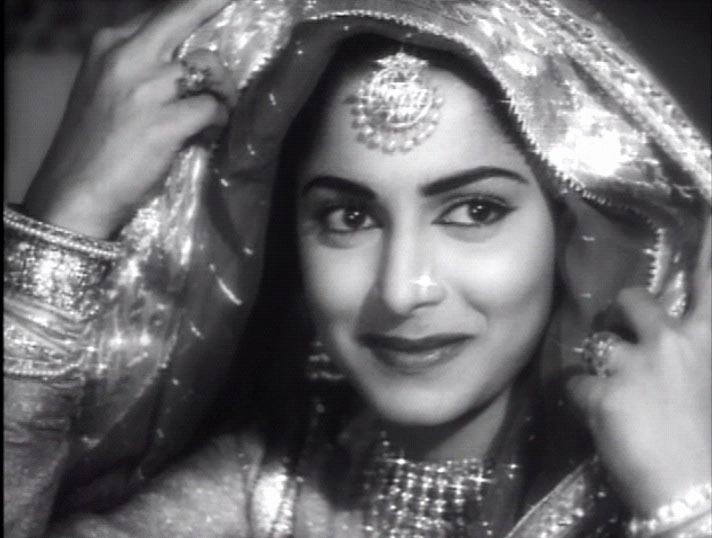 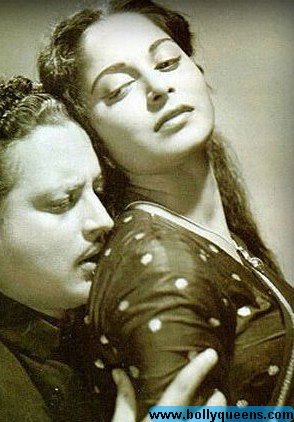 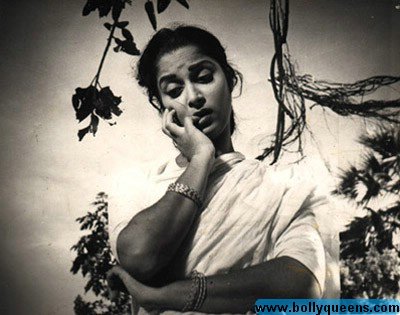 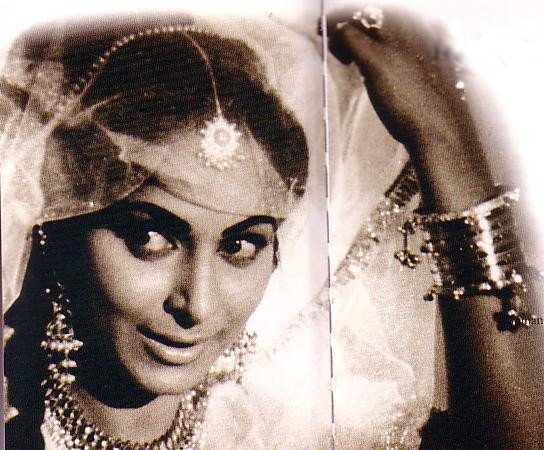 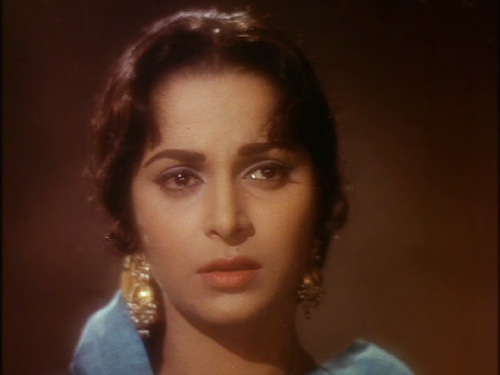 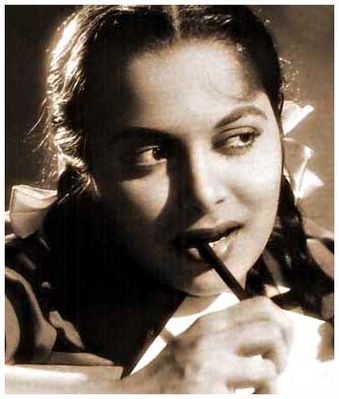 With Pyaasa came success and Waheeda got involved with Guru Dutt, but it was an unsuccessful love affair and Guru dutt's marital status and her growing success tore them apart. They acted in four classic movies including Pyaasa.....Chauduvin ka Chand,Sahib bibi aur Ghulam and the semi autobiographical Kagaz ke phool.........Guru dutt committed suicide in 1964... Her career continued throughout the 1960's, 1970's and the 80's....She has been paired with most of the top leading heroes be it Dilip kumar, Raj kapoor or Dev anand.....Guru dutt,Sunil Dutt, Dharmendra, Pradeep Kumar,Amitabh bachchan,Rajesh Khanna, Manoj kumar,Rajendra kumar,Biswajeet....a long list indeed.... 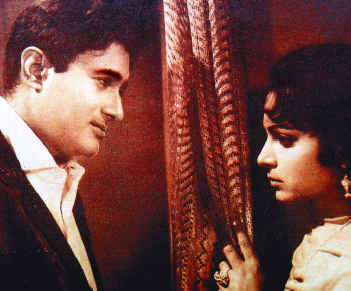 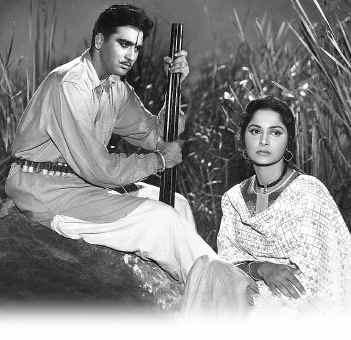 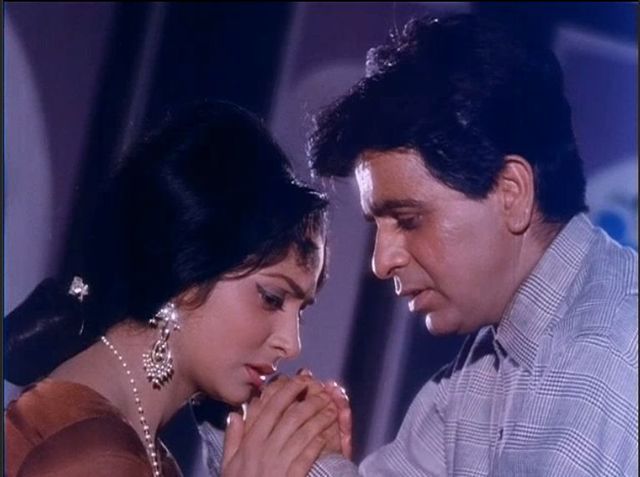   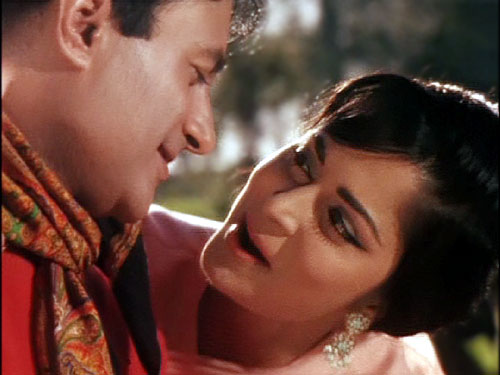 Memorable films... CID Pyaasa Solva saal Sahib bibi aur ghulam Kagaz ke phool Kala bazar Roop ki rani chorn ka raja Chauduvin ka chand Bees saal baad baat ek raat ki Ek phool char kaante Kohra Guide Teesri kasam Ram aur shyam Dil diya dard liya Patthar ke sanam Palkhi Aadmi Shagun Neel kamal Khamoshi Kabhi khabhi Trishul..... Impressive collection of films.... She won the Filmfare best actress award for her role in Guide (1965) and neel Kamal ( 1968)... She has won the Lifetime Achievement award in the year 1995 and The special award for 'Invaluable Contribution to the Indian Cinema' in 2001.... Waheeda Rehman married Kamaljeet (who was her costar in Shagun) on April 27 1974 and after her marriage she shifted to Bangalore and concenterated on raising her family,occassionally acting in some quality films . She has two children, son Sohail and daughter Kashvi.....Her husband Kamaljeet died on November 21,2000 following a prolonged illness.... 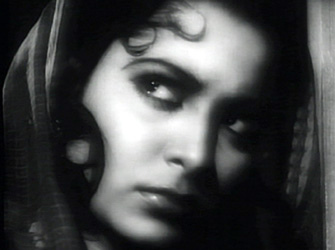 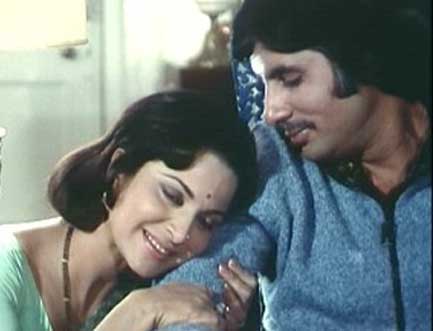 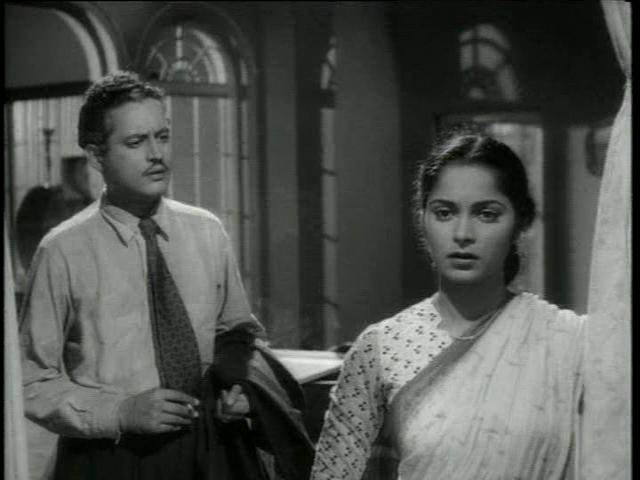 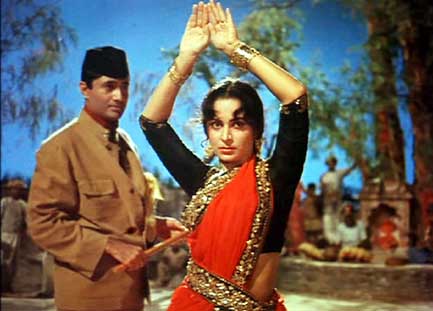 Waheeda Rehman has settled down in Bangalore where she is involved in a business venture marketing her own brand of breakfast cereals and leads a contented life in her farm house. Waheeda Rehman combined the classic Islamic beauty with an extraordinary grace, talent and a truly transcendent appeal that ranked her among the Pantheon of Bollywood's elite actresses... Attached image(s) 
The greatest discovery of my generation is that human beings can alter their lives by altering their attitudes of mind -William James |
| Reeth |
 Jun 21 2007, 02:14 AM Jun 21 2007, 02:14 AM
Post
#270
|
 Dedicated Member  Group: Members Posts: 2154 Joined: 22-May 06 Member No.: 6151 |
THE BEAUTIFUL GIRL…..MADHU BALA It seems both ironic and incongruous that my relationship with the leading lady of Indian cinema in the late 1940s and early 1950s - a relationship that was among the most meaningful in my life, and not only as a film journalist - should have begun on an inauspicious note. For a scene to be shot at China Creek for a Hindi film whose title I cannot now recall, a ban was imposed by Madhubala, or, more correctly, by her formidable father, Khan Ataullah Khan, on film journalists and photographers from visiting that particular set. Hastily, and rather thoughtlessly, the film press responded by imposing a total blackout of Madhubala in the film press. I was appointed, without being consulted, chairman of the blackout committee. In my considered opinion, then as now, both the ban and the response to it were uncalled for and, worse, ineffective. I told the journalists that the press needed Madhubala as much as Madhubala needed the press. In the dispute, the reaction of her many, many fans was not taken into account. The matter dragged on purposelessly for a couple of months till, one fine morning, Khan Saheb summoned the photographer Ram Aurangbadkar, my right-hand man in Movie Times which I then edited, and told him that the dispute was pointless and, as a gesture of goodwill, invited the film press to a tea party at Madhubala’s residence Arabian Villa in Bandra. Arabian Villa, a picturesque little cottage in a Bandra side-lane, was one of many such cottages that sprawled all over the suburb in those days. At the villa’s gate, along with the security guards, stood Khan Saheb with a genial smile welcoming us journalists, eight or nine of us. We were taken to a small but elegantly decorated, richly-carpeted, drawing room. Unlike the other filmstar homes I’d visited, not a single portrait of Madhubala adorned the walls. I hadn’t met Madhubala (her real name was Mumtaz Begum) earlier, but I had seen several of her films and had been impressed by her attractive personality and her obvious budding talent. I wasn’t prepared for the woman I saw slowly descending a curved staircase from the upper floor. It was as if a vision of beauty had achieved form and presence, in a simple white sari and matching sandals, right in front of my eyes, without a touch of make-up. I was so struck that I forgot my manners and didn’t stand up when, before greeting everyone else, she stood before me, her manicured hands together in a namaste. I struggled to my feet, still feeling dazed, mumbled an apology for not standing up earlier and returned her namaste. With a dazzling smile, showing her pearly white teeth, she put her hands on my shoulders and pressed me down back into my seat. Then she went on to greet my wife and the other guests. My first thought was, “How could the camera have so signally failed to capture that quite extraordinary beauty?” I was to find my answer to that later. I couldn’t take my eyes off her. Her deep brown hair loosened and fell around her shoulders; her complexion I can only describe with the cliché “peaches and cream”. Her eyes were luminous of a light brown, whose shade kept lightening or darkening according to her moods. But they were the most expressive features on her face. So was her voice, soft and low with a sexy huskiness to it. Then, suddenly, the answer came to me. Her films which I had seen were in black and white. Colour had not then come to Indian cinema. Only colour could do justice to the flush even now glowing on her cheeks. Khan Saheb was holding forth on which films had been hits and which had flopped. There was a lot of discussion on this. Khan Saheb mentioned a particular film in which Madhu, as he called her, had been a big hit. “No doubt,” my wife, who reviewed Hindi films for my paper, said. “But it was a frame by frame copy of an American film.” She named the film. Khan Saheb was taken aback. One could see his mind working on a rebuttal, “Don’t you see, Madam, when someone sets a good example, we follow it. What’s wrong with that?” He could be quite cynical at times. Khan Saheb was a rather short, thick-set man. A dangerous enemy but, as we were to discover, a wonderful friend. His geniality could not conceal a trace of bitterness in his face, maybe because of the struggles he had faced bringing up his daughters. Madhubala had sisters, too, whom I was to get to know much later. I noticed that his cheeks were flushed. He suffered, I learned, from high blood pressure. It was rumoured that he was the father of eleven children, of whom Madhubala was the fifth. It was now time for tea. Madhubala carried the tray herself. She brought it to me, questioning me with her eyes, holding up the sugar spoon. “One, please,” I said. She put in one, then holding up the sugar-filled spoon again, looking straight into my eyes, mischievously, tauntingly, she added that one too. As she moved around with the tray, I noticed the spring and suppleness of her movements. There was something startlingly different about her from the other stars I was friendly with, as if she carried an aura about her. It was my first meeting with Madhubala, but somehow it seemed to me that I had known her for a long, long time. Perhaps it was a prescience of things to come. It was a friendly meeting. Soon, too soon, it was time to leave. The journalists were given a lift home in Madhubala’s Town and Country station wagon. Abad and I had our own car and we were saying goodbye too, when with a concealed gesture of his right hand Khan Saheb indicated that we should stay behind. I had earlier noticed his rather condescending attitude to the others compared to his friendliness, almost humbleness with us. Now he made it obvious. “I respect you, Mr Karanjia, for two reasons. Movie Times shows courage in fighting our industry’s battles and I respect you personally for bringing dignity to film journalism. That’s all I wanted to tell you.” I felt flattered. He expressed the desire to be in constant touch. We had honoured him by visiting his home and he would reciprocate by visiting ours. He took down our address and both home and office telephone numbers. Then both father and daughter came down to our humble Ambassador to see us off. As we were driving back to our home in Chowpatty, Abad remarked quite out of the blue, “I think she’s taken a shine to you, Burjor. Better be careful.” “She? You mean him, her father. She hardly spoke a word to me the entire evening. It was he who kept buttering me up. He realises the power of Movie Times. He’s always involved in some controversy or the other and would like to have us on his side, I suppose,” I said. I was wondering if and when we’d meet again. A couple of days later, I had hardly sat down at my desk to check the proof pages of the next issue when the phone rang. It was Khan Saheb. I could never mistake his high-pitched, rasping voice. He thanked me again for coming to his home and enquired if I was free the next Sunday afternoon at about 4 pm. I said it would be a pleasure to meet him again. I told him that our house stood exactly behind the Orient Club on Chowpatty sea face and we were on the third floor. He said not to worry, he’d find it. He enquired after “Madam” (my wife) and then told me to hold on, Madhu wanted to say hello. My heart jumped. She also thanked me. I told her how happy I was to have met her and added that I found her more beautiful in person than on the screen. It was my eyes that had made her beautiful, she replied. It sounded like a bit of dialogue from a Hindi film, but it was music to my ears. She asked about my daughter Rutton about whom my wife had spoken to her and expressed a desire to meet her some time. Our conversations were always bilingual, she spoke to me in Hindi, and I, in English. On the frequent occasions we met, she would try to speak a few sentences in English “for practice,” she said. Well, her English did improve, but my Hindi remained the same. That call made my day. Our relationship wasn’t ended with the meeting at Arabian Villa. I rubbed my hands in glee. Khan Saheb arrived on the dot, dressed in a cream silk shirt and white trousers, and wearing chappals. “You have a huge house,” he remarked, looking around and adding, “and look at that ceiling, it’s so high, you don’t get houses like this these days. It must be a very old house.” “Yes,” I said, “it was my grandfather’s gift to my mother when she got married. I introduced him to my mother who was sitting at the other end of our drawing room. He bowed to her with deep respect. And when little Rutton came in, all dressed up for the occasion, he fondled her cheeks and drew her close to him and indulged in a bit of child talk. Over tea we discussed the deteriorating conditions of filmmaking in India, black money pouring in, trade bodies at loggerheads with one another, freelancing filmstars working in several films at the same time, the lack of a strong organisational base and of a film policy worth the name. It became a habit with him to visit us every alternate Sunday afternoon. I grew to like him, even admire him for his deep knowledge of cinema and for the strict discipline he was able to enforce on his daughter which should have set an example to other freewheeling stars. On one occasion I recall, the city was flooded with rains. Transport had come to a standstill. Still Madhubala managed to reach M&T Studios on time, at 9 am, only to learn that the shooting had been cancelled. One Sunday, to my great joy, Madhubala accompanied her father to our home, carrying a huge box of sweets for Rutton. She became extremely friendly with my wife and, believe it or not, actually played hide-and-seek with Rutton in our 5,000-square-foot flat. The child was still present in the woman I was getting to know. When I came down to the garden to see the star and her dad to their car, I could see neighbours peering from their windows. There was also a small crowd around the car, since in India filmstars are recognised by the cars they own. I sensed that the star’s visit had somehow elevated our status in the neighbourhood. Madhu — I began to call her that — would often ring me up, seeking my advice on a particular role she didn’t like to play or convey to me some currently raging scandal. One thing she particularly admired in Movie Times and even the monthly “Cinevoice” which I edited was that we never indulged in film gossip. I once told her that while gossip sells, there’s more to selling than gossip as the circulation figures of Movie Times clearly proved. On my weekly studio rounds, I made it a point to include whatever studio she was working in. Whenever she spotted me, her face would light up with a welcoming smile, and as soon as the shot was over she would come to sit with me and order tea for both of us. Our closeness was becoming apparent but it had such a dizzying effect on me that I couldn’t have cared less. We were not doing anything wrong. We let things take their course. But then, what about the world’s sense of right and wrong? I soon realised the impossibility and, yes, the absurdity of our friendship getting any closer. I was married, and happily too. Abad and Madhu became extremely fond of each other. Madhu’s father had tremendous faith in me and any such “affair” would have shattered him. Above all, I had my own code of honour as editor of a powerful paper — never, ever, mix business with pleasure. I would have been seriously compromised and Madhu even more than me. In the meantime a crisis was brewing on the office front. For some time, we had been facing financial problems as a direct result of filmdom’s uncertainties. If a film flopped, its producer made that an excuse for not paying for the advertisements he had put in the paper. He would plead with us to be patient till he had his next hit. And in an industry in which there were at least ten flops to each hit, this became a major problem. If we insisted on an immediate payment, we would get a rubber cheque. The file containing rubber cheques had pride of place as being the thickest among our office files. In desperation, in one or two cases we did file legal suits. But the industry’s ways were so devious, we ended up by losing more money, good money after bad. But let me be fair. There were distributors like K.K. Kapoor, producers like Seth Chandulal Shah and actor-directors like Raj Kapoor who came to our rescue by booking a full year’s advertising in our paper and paying in advance. But these were in a hopeless minority. There were occasions when we didn’t have the means to bring out the next week’s issue. My financial director, A.M. Kapadia, who also had invested in the paper, threw up his hands in despair. Movie Times was my life; it now appeared that it had been lived in vain. We had finance enough for a couple of months, after which we took the decision, bitter as it was, to close down the publication. But we had reckoned without Madhubala. One evening my wife and I were having coffee at Bombelli’s, as was our practice, when Ram Aurangabadkar joined us. He looked quite excited, for Movie Times meant as much to him as it did to us. He told us how, meeting Khan Saheb by accident on his studio rounds, he mentioned in passing to Khan Saheb that Movie Times would shortly be closing down and he was shocked. “I will never allow Movie Times to close down,” he said. He made a tempting offer to Ram that I should produce a film and Madhubala would work free in it. Her price then was Rs two to three lakhs per film, and we could utilise that to carry on. Even as he was telling us this, I recalled how during the “Madhubala ban” days, Khan Saheb had referred to film journalists as kutte (dogs) who devoured the chunks thrown to them by the likes of him. I rejected the offer and Ram, also a man of integrity, agreed with my decision. Besides, the very idea of producing a film seemed preposterous to me. The very next day Madhubala rang, requesting an urgent meeting with me. I would have invited her to lunch or dinner, as I had done with other stars, but it was out of the question in the case of Madhubala who had never been to a five-star hotel and was a recluse by nature. I felt quite frustrated, when Madhu herself came up with a solution. Her driver would pick me up from home and we’d go for a drive in her Town and Country and talk. As soon as she saw me, she lowered the burkha she was wearing to her shoulders. Madhu pleaded with me, holding my hand in both hers, to accept her offer. I told her how deeply grateful I was, but that what she was suggesting wouldn’t help in the long run. But she had her answer ready, “I’ll do two pictures, three, as many as you wish, but I want your paper to survive” (after a pause) “so does my father.” I shook my head and tried to explain that it wasn’t a question of three pictures or thirty, the basic mistake I had made was to launch both my papers in an individual capacity, without any institutional support. Conditions in the film industry being what they were and with men not respecting their own signatures, we’d go deeper and deeper into loss. I was grateful to her, I’d always be grateful, but as one who cared deeply for her, I couldn’t and wouldn’t allow her money to go down the drain. Did she realise what the film world would make of a filmstar coming to the rescue of a film journalist? It would cause a scandal of unimaginable proportions and would affect her stardom and compromise my integrity. “If you really cared for me, you wouldn’t insist. You’d try to understand my helplessness,” I said. She fell back into her seat, looking quite forlorn. “What about me, what about our friendship? How am I going to convince my father? He’ll be heartbroken. What are you going to do about your career?” she asked. I assured her as solemnly as I could that we’d always be friends, her friendship and affection meant a lot to me, even more than it did to her. I’d explain to Khan Saheb when he came next Sunday and I’m sure he’d understand. And as for my work, I had already received the offer of a job as PRO of the vast Godrej enterprise, she need have no worry on that score. She smiled for the first time that evening. A desire to hold her in my arms flared like a fire inside me. With a tremendous effort I subdued it. I don’t recall how many rounds the station wagon made from Chowpatty, up Walkeshwar, across Malabar Hill, round Kemp’s Corner and Hughes Road and then back all over again. We were together for almost an hour. Before getting down at Chowpatty, I told her I wanted to thank her for a great lesson I had learned from our relationship. Her eyes opened in wonder. “You taught me, dear Madhu, that true love survives the body’s passion. Passion gets spent, love survives and triumphs. And I am doubly glad that I learnt this lesson from one whom I consider the most beautiful woman I’ve met.” She looked down and was silent for a long time. Then quickly, she took my hand to her lips. Movie Times closed down, not with a whimper but a big bang, with the staging of “Constellation Night”, a star show in aid of charity at which we got Suraiyya to sing on the stage for the first time in her career. Radiant in the first row sat Madhu, next to Dilip Kumar. When, years later in 1961, I was appointed editor of Filmfare, Madhu’s was the first phone call to congratulate me. She said the news made her happier than she had ever been. It proved her faith in me. Of course Madhu and I continued to be the best of friends. I heard rumours that Dilip Kumar wanted to marry her, but Khan Saheb objected, I’ve no idea why. Then suddenly, I heard that she had married the singer Kishore Kumar. It seemed to me the unlikeliest of marriages, even by Bollywood standards. A couple of years later she fell sick with a heart ailment, for which there apparently was no cure. Khan Saheb took her to London, but her health became worse. She was confined to bed and her shooting days appeared to be over. The film industry forgot her, but I continued to send flowers on her birthday even though she was no longer a star. I’ve described in my book Counting My Blessings my visit to her, it was my last visit, as she lay dying in Breach Candy Hospital. After considerable persuasion I was allowed to see her for just three minutes. Three minutes after a lifetime of companionship! She couldn’t speak because of tubes in her mouth and nose. But immediately I saw recognition in her eyes and, what particularly cheered me, the remembrance. She held my hand as she had always done and we continued looking into each other’s eyes. She wouldn’t let go off my hand, though the nurse asked me to leave. I loosened her hand with both mine and bent to kiss her on her pale, moist brow. She gave a deep sigh as if in contentment, and then closed her eyes. My eyes were moist, my features were crumpling as I tiptoed out of the room. Seeing me, the nurse followed me out and put her hand on my shoulder and whispered just one word “Pray!” Madhu died two days later on February 20, 1969. She left me with two regrets. One, that colour had not come to Indian cinema in the heyday of her career. And second, that just a year after her death, I read in the Lancet medical journal that at last a cure had been found for the ailment she suffered. Fate implacably drives men and women to self-knowledge and an acceptance of their limitations. I spoke earlier of Madhubala giving a meaning to my life. My memory of her is still vibrant. Almost 40 years after her death, the enchantment is still with me. No, she is not lost to me. By B.K.Karanjia Great article mahesh The greatest discovery of my generation is that human beings can alter their lives by altering their attitudes of mind -William James |
  |
2 User(s) are reading this topic (2 Guests and 0 Anonymous Users)
0 Members:

|
Lo-Fi Version | Disclaimer | HF Guidelines |  |
Time is now: 2nd May 2024 - 04:41 PM |
Invision Power Board
v2.1.7 © 2024 IPS, Inc.
Licensed to: Hamaraforums.com









